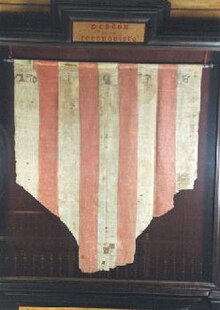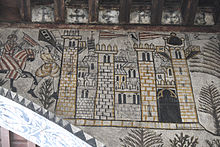Pennon of the Conquest
- View a machine-translated version of the Catalan article.
- Machine translation, like DeepL or Google Translate, is a useful starting point for translations, but translators must revise errors as necessary and confirm that the translation is accurate, rather than simply copy-pasting machine-translated text into the English Wikipedia.
- Do not translate text that appears unreliable or low-quality. If possible, verify the text with references provided in the foreign-language article.
- You must provide copyright attribution in the edit summary accompanying your translation by providing an interlanguage link to the source of your translation. A model attribution edit summary is
Content in this edit is translated from the existing Catalan Wikipedia article at [[:ca:Penó de la Conquesta]]; see its history for attribution. - You may also add the template
{{Translated|ca|Penó de la Conquesta}}to the talk page. - For more guidance, see Wikipedia:Translation.


The Pennon of the Conquest (Spanish: Pendón de la Conquista; Valencian: Penó de la Conquesta) is the flag raised by the Moors of Valencia, Spain, on September 28, 1238, on the tower of Alī-Bufāt, later called Torre del Temple, to indicate their surrender to the troops of king James I of Aragon. This episode is known from the quote entered by the king himself in his Chronicle: "We were in the riverbed, between the gardens and the tower; and when we saw our flag upon the tower, we dismounted from our horse, and heading eastwards we cried from our eyes and kissed the earth for the great mercy God had made to us".[1]
The Pennon is made of three pieces of white cloth (which the passage of time has turned into yellowish) sewed together, cut to give the flag a gonfalon shape, upon which 4 red stripes have been painted. It is about 2 m long and on top an epigraph reads año 1238 ("year 1238"). After the Conquest of Valencia it was considered a relic and was kept by order of James I of Aragon in the Church at Saint Vincent Hospital up to the 19th century, when it was transferred to its current location in the City Hall of Valencia, Spain.
See also
- Flag of Valencia
- Senyera
References
- ^ Coscollá Sanz, Vicente (2003). La Valencia musulmana. Valencia: Carena Editors. pp. 131–135. ISBN 84-87398-75-8. OCLC 54192618.
- v
- t
- e
- Spain
- Royal Standard
communities
- Andalusia
- Aragon
- Asturias
- Balearic Islands
- Basque Country
- Canary Islands
- Cantabria
- Castile–La Mancha
- Castile and León
- Catalonia
- Extremadura
- Galicia
- Community of Madrid
- Region of Murcia
- Navarre
- La Rioja
- Valencian Community
  | This Spanish history–related article is a stub. You can help Wikipedia by expanding it. |
- v
- t
- e
 | This European flag–related article is a stub. You can help Wikipedia by expanding it. |
- v
- t
- e











